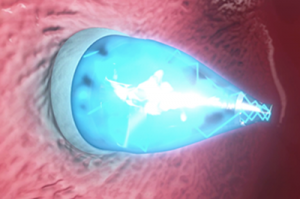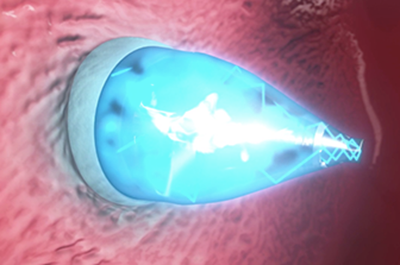Catheter uses UV light to repair holes in the heart without invasive surgery
A medical breakthrough by researchers from Boston Children’s Hospital, the Wyss Institute for Biologically Inspired Engineering at Harvard University, the Harvard John A. Paulson School of Engineering and Applied Sciences (SEAS), and the Karp Lab at Brigham and Women’s Hospital could change the course of cardiac surgery forever.
Together, the teams have designed a specialized catheter for fixing holes in the heart using a biodegradable adhesive and patch. They have taken that discovery even further by incorporating UV-light technology in order to place the patch into a beating heart.

How it works
First the catheter is inserted through a vein in the neck or groin and directed to the defect within the heart. Once in place, the doctor opens two positioning balloons: one around the front end of the catheter, passing through the hole, and one on the other side of the heart wall. Then he or she deploys the patch and turns on the catheter’s UV light. The light reflects off of the balloon’s shiny interior and activates the patch’s adhesive coating. As the glue cures, pressure from the positioning balloons on either side of the patch help secure it in place.
Once both of the balloons are inflated and in place, the catheter is removed. Over time, normal tissue growth resumes and heart tissue grows over the patch, which eventually dissolves when it is no longer needed.
So far the device has been tested successfully on animals proving that holes in the heart can be closed without open-heart surgery.
“This really is a completely new platform for closing wounds or holes anywhere in the body,” said Conor Walsh, Ph.D., contributing author on the study, Wyss Institute Core Faculty member, Assistant Professor of Mechanical and Biomedical Engineering at SEAS, and founder of the Harvard Biodesign Lab at SEAS, in a press release. “The device is a minimally invasive way to deliver a patch and then activate it using UV light, all within a matter of five minutes and in an atraumatic way that doesn’t require a separate incision.”
Many medical professionals prefer catheterizations instead of open heart surgery because the procedure does not require stopping the heart, putting the patient on bypass, and cutting into the heart, according to a Wyss Institute news release.
The technology could pave the way for additional cardiac surgery changes in the future.
Story via Wyss Institute/ Harvard University.

